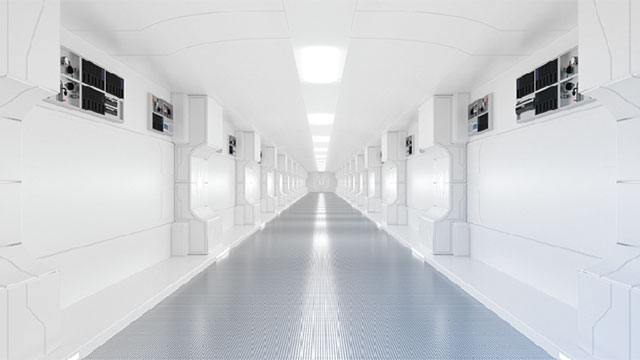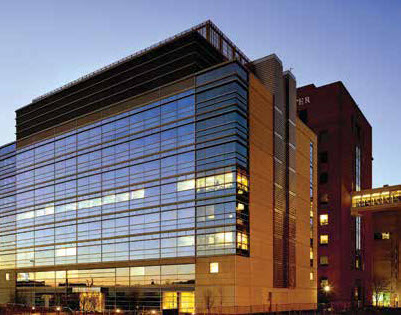Building a Future-Friendly Lab
Flexible design and access to talent are the keys to agile research and development

The death of the blockbuster drug has forced a reckoning in laboratory design—one that’s exposed new pathways to a more agile, future-friendly lab. We know the lab of the future must leave behind old conventions, so scientists can more quickly bring meaningful therapies to patients. It’s clear that speeding up innovation has become critical to making research and development (R&D) viable in a time of an ongoing decline in profits. The next-generation laboratory must be flexible and easily adaptable to help reduce R&D costs and enable faster new product development.
Blockbuster drugs were typically made in industrial strength labs—and industrial-strength measures were required to reconfigure them as new research priorities emerged. Facing changing patient needs and ongoing financial pressure, most biopharmaceutical companies simply no longer have the kind of time or extra funding that major lab redesigns traditionally require. Nor can companies afford to offer up mediocre space simply because it fits a budget. Today’s top talent won’t be inspired by yesteryear’s lab design, nor should they be.
It’s clear that life sciences and biopharmaceutical companies need new ways to shorten R&D timelines while focusing on cost reduction and ongoing industry consolidation. R&D returns for large biopharmaceutical firms fell from 10.1 percent in 2010 to a feeble 3.2 percent in 2017. What’s been less clear, until now, is how to achieve the lofty goal of a shorter, more productive R&D timeline.
Fortunately, new approaches to physical space have emerged that make a genuine contribution to the effort, according to “Journey to the Next Gen Lab,” a new report by JLL (Chicago, IL). From more flexible space that promotes agility amidst rapidly shifting research priorities to tech-driven features that can help organizations leverage big data and attract talent, innovation in lab design can lead to more efficient innovation in the work itself.
Following are three lab design trends helping organizations achieve a “faster, lighter” lab of the future.
Trend 1: Designing for flexibility and collaboration
“Eureka!” moments can happen anytime—unlike a traditional laboratory transformation. Historically, reconfiguring a pharmaceutical or biotech lab to support research for an all-new remedy or cure has been a time-consuming and expensive undertaking. But that’s changing as life sciences companies increasingly steer clear of conventional lab designs in favor of flexible spaces to keep up with the pace of innovation.
Amidst rapidly shifting research priorities, forward-looking lab designs are those that can be easily reconfigured to accommodate different kinds of research and help scientists perform their studies as quickly as possible. Also important are spaces that facilitate creative interaction with colleagues, preferably without requiring de-gowning.
As evidenced by JLL research, R&D real estate is already becoming more highly flexible and multi-use. Although flexibility enhancements bring some upfront cost considerations, the ability to easily move heavy-duty items such as chemical fume hoods can make R&D more cost efficient in the long run.
For example, mobile benches and unassigned workspaces are being used to allow for fast changes in personnel and/or the type of work being performed. Some lab designers are installing retractable electrical cords in the ceiling and technical infrastructure into movable facades so workspaces can be set up in different configurations around the lab floor, rather than being limited to fixed walls. Another strategy is to build heavy-duty floor slabs in laboratory corridors to accommodate periodic moves of heavy equipment.
Trend 2: Less wet lab, more computational science space
Lab samples are no longer the only subject worthy of close analysis. Thanks to continuing advances in data and analytics technology, as well as access to large data sets, drug development has become increasingly integrated with data science. With the help of cloud computing, researchers can quickly access, search, and analyze electronic health records and genome research for new insights. And analytics-fueled research comes with lighter regulatory requirements than, say, research involving animals or hazardous materials.
 Boston University’s BioSquare facilitycourtesy of JLL Project and Development ServicesYet all that computing requires seats, desks, power, and space. As a result of the growing promise of computational science, wet labs are shrinking to make way for more office space. In terms of lab design, the evolution represents a fairly significant shift in space utilization when you consider that a traditional R&D facility typically consists of mostly lab space and a relatively small proportion of office space.
Boston University’s BioSquare facilitycourtesy of JLL Project and Development ServicesYet all that computing requires seats, desks, power, and space. As a result of the growing promise of computational science, wet labs are shrinking to make way for more office space. In terms of lab design, the evolution represents a fairly significant shift in space utilization when you consider that a traditional R&D facility typically consists of mostly lab space and a relatively small proportion of office space.
The rise of artificial intelligence, machine learning, and other computing technologies in laboratories only adds fuel to the fire of change. In the future, lab proportions will likely shift to equal parts wet labs, flex space, and office space for data scientists. The shift in research modes could also help decision-makers divert funding from sensitive lab requirements, such as bacteria-resistant countertops and sinks, to state-of-the-art data analytics tools, such as electronic laboratory notebooks and powerful computer systems.
Trend 3: Focusing on talent recruitment and retention
The war for talented biologists and chemists is ongoing, with no sign of relief in sight with the concurrent pressure for more productive R&D. Adding to the pressure is the growing competition for in-demand data scientists to work with today’s voluminous research data. Life sciences R&D organizations must compete for data scientists not only against the major technology companies—whose reputations for offering highly desirable workplaces are considered by some to be unrivaled—but also against companies outside the technology sector.
This mandate to attract and retain more skilled talent is having a ripple effect on major real estate decisions, as illustrated in JLL’s “Life Sciences Outlook” report. Biopharmaceutical companies are intensifying their drive to be near leading academic research centers and the supportive R&D ecosystems that surround them, despite the high rents of attractive cities like San Francisco, San Diego, and Boston.
Talent wars are also contributing to a growing focus on amenities, aesthetic appeal, state-of-the-art equipment, and attention to sustainable design. The dark labs of yesteryear are giving way to lab designs that incorporate natural light, sustainability features, and attractive sight lines that, ideally, will promote well-being and inspire creative thinking about research problems.
Rather than hiding R&D space deep inside a facility, for example, some biopharmaceutical companies are creating lab spaces on the perimeters of their facilities to showcase their cutting-edge technologies and abundance of natural light. Perimeter placement serves the dual purpose of attracting new recruits while also making it easy for senior scientists to pop in after hours or on weekends to check a test result—a convenience that can help boost retention, too.
Collaboration-friendly space in particular can be a game changer for organizations looking to spark the interest of the next generation of scientists. Many of today’s science students demonstrate a strong desire to share ideas with their peers and prefer spaces where they can learn as teams, rather than in isolation. Forward-looking R&D organizations are providing comfortable, inviting places for formal and informal collaboration to spark great ideas.
Smart technology is also becoming a differentiator in the lab workplace. Some labs are adopting Internet of Things technologies—from smart safety goggles and self-cleaning lab benches to sensor-powered sample freezers. Providing access to the latest tech-enabled tools not only helps attract new talent, but also can help employees become more efficient and nimble.
The future of lab design is flexibility
It’s become abundantly clear that flexible lab design and access to talent are the keys to agile R&D. By investing in adaptable laboratory features today, a biopharmaceutical company can position its R&D operations for long-term agility. And investment in sustainable, inspiring design that fosters well-being and makes room for collaboration can further advance the ultimate goal of R&D: the next great breakthroughs.
Is your organization ready for the future of R&D? If you’re creating your next-generation lab around the needs of both your ever-changing research priorities and the newest generation of scientists, the answer could be yes.

